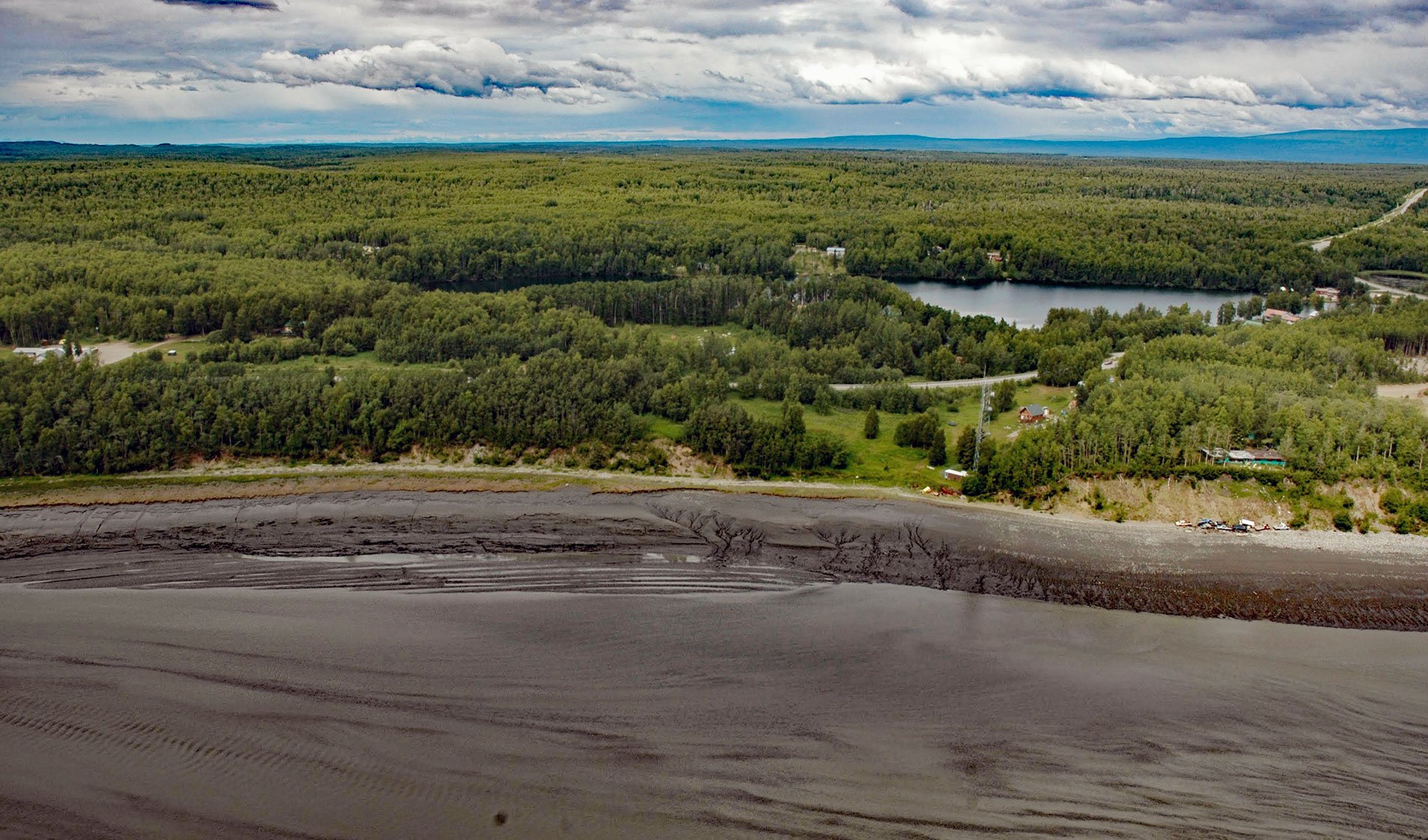Knik village is a historic Dena’ina community situated between the northwest shore of Knik Arm in Cook Inlet to the east and Knik Lake to the west, about 18 miles (29 km) north-northeast of Anchorage and 13 miles (21 km) southwest of Wasilla, Alaska. The name is derived from the Dena’ina word for ‘fire’ and was first reported by Ivan Petroff as ‘Kinik’ in the 1880 U.S. Census. Knik Arm is about 15 miles (24 km) long and is the estuary of the glacier-fed Matanuska and Knik rivers. The Dena’ina name for Knik Arm is ‘Nuti’, meaning ‘saltwater’. The village is underlain by a vast deposit of unconsolidated sediments between Knik Arm and the Susitna River to the west. The sediments along Knik Arm are mostly alluvial fan deposits that developed during the Holocene and Late Pleistocene and consist of silt to boulders. Farther inland, the sediments represent major glacial moraine and kame deposits from the Late Pleistocene. Most moraines represent glacier readvances during the general retreat from maximum positions. Lakes, ponds, areas of peat deposits, and narrow channels are common. Kame fields consist of irregularly shaped and relatively sharply defined hills and eskers that mainly consist of gravel and sand with some diamicton.
For millennia, Knik village relied on subsistence fishing and hunting, trapping, and bartering. Between 1850 and 1880, journals kept by Russian priests described Knik as a group of semi-permanent camps. In 1889, Russian missionary Father Nikolai Mitropol’skii helped build Saint Nicholas Chapel which helped centralize the village but was later moved. In 1893, Vladimir Stafeev, the Russian trade agent at Tyonek, described Knik Station as having one Alaska Commercial Company trading post, one Euro-American trading agent, one Dena’ina interpreter, a handful of Native residents, and only three permanent buildings. In the late 1890s, the discovery of gold brought thousands of prospectors to Southcentral Alaska. Large steamships and schooners transported miners from Seattle to Prince William Sound, Resurrection Bay, and Cook Inlet. Seldovia was the only deepwater port for large ships in Cook Inlet, and hopeful miners would travel across the Kenai Peninsula to Sunrise or Hope. Smaller schooners could travel farther north in Cook Inlet to Tyonek, where miners could buy or build a boat and venture to Knik, and from there on to the Susitna and Matanuska river valleys. In 1911, the Federal Government opened a trail for mail delivery from Seward on Resurrection Bay to Nome. It was called the Iditarod Trail and it was used mainly by men traveling to and from gold country. The Iditarod Trail went through Knik and brought money and employment to the town. On January 10, 1912, four Iditarod dog teams, carrying 2900 pounds (1315 kg) of gold bullion arrived at Knik. The news fueled gold fever even more, and soon the Iditarod trail was lined with prospectors heading north and dog teams pulling sleds of gold south.
By 1912, Alaska became a Territory of the United States and the U.S. Congress passed the Second Organic Act for Alaska which resulted in plans to extend the railroad connecting Seward and Kern Creek to the Matanuska-Susitna Valley with a branch going to the Matanuska coal fields. Almost immediately, teams of surveyors and clearing crews descended on Knik, building barns for horse teams, a storage building, and a mess hall. All of this activity and the prospect of jobs fueled more growth for Knik, but in 1914, the railroad built a headquarters at Ship Creek. In January 1916, tracks were completed between Anchorage and Peters Creek. Two months later, the rail reached the village of Eklutna, and a right of way was cleared to the next railroad construction camp called Wasilla. The residents of Knik, which was at its population peak that year, realized that the new railroad route would bypass the town and some people moved to the Ship Creek tent city, the future site of Anchorage. On May 2, 1917, the railroad tracks reached Wasilla and quickly became the center for the supplies that gold miners and homesteaders required. Accepting the inevitable, in the summer of 1917, Knik residents started dismantling their buildings and shipping them to the new town of Anchorage by boat, or to the new town of Wasilla by horse and wagon. Only a few old-timers and one general store remained in Knik. In 1917, the store burned to the ground and was never rebuilt. Today, only two buildings survive, a two-story saloon that once served as a roadhouse and later a store, and a small log cabin. Read more here and here. Explore more of Knik and Knik Arm here:

